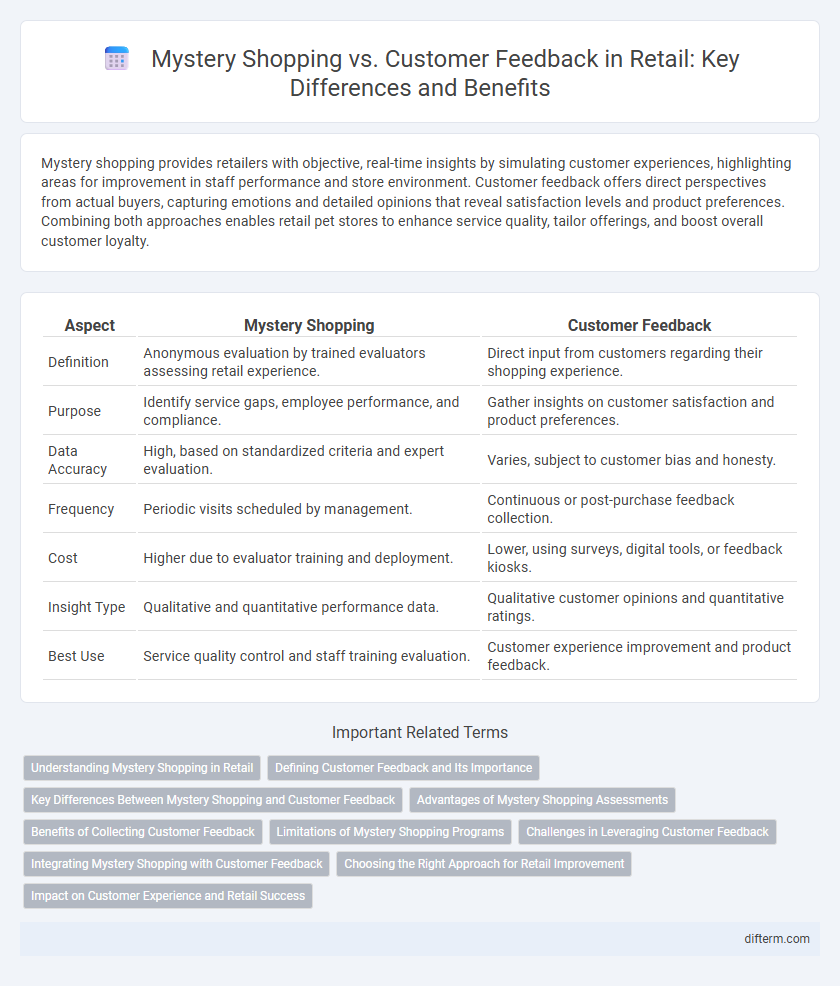Mystery shopping provides retailers with objective, real-time insights by simulating customer experiences, highlighting areas for improvement in staff performance and store environment. Customer feedback offers direct perspectives from actual buyers, capturing emotions and detailed opinions that reveal satisfaction levels and product preferences. Combining both approaches enables retail pet stores to enhance service quality, tailor offerings, and boost overall customer loyalty.
Table of Comparison
| Aspect | Mystery Shopping | Customer Feedback |
|---|---|---|
| Definition | Anonymous evaluation by trained evaluators assessing retail experience. | Direct input from customers regarding their shopping experience. |
| Purpose | Identify service gaps, employee performance, and compliance. | Gather insights on customer satisfaction and product preferences. |
| Data Accuracy | High, based on standardized criteria and expert evaluation. | Varies, subject to customer bias and honesty. |
| Frequency | Periodic visits scheduled by management. | Continuous or post-purchase feedback collection. |
| Cost | Higher due to evaluator training and deployment. | Lower, using surveys, digital tools, or feedback kiosks. |
| Insight Type | Qualitative and quantitative performance data. | Qualitative customer opinions and quantitative ratings. |
| Best Use | Service quality control and staff training evaluation. | Customer experience improvement and product feedback. |
Understanding Mystery Shopping in Retail
Mystery shopping in retail involves hiring trained evaluators to pose as regular customers and objectively assess store performance, staff behavior, and adherence to brand standards. This method provides detailed, actionable insights that go beyond typical customer feedback, which often reflects subjective opinions and emotions. By systematically capturing in-store experiences, mystery shopping helps retailers identify operational strengths and weaknesses to enhance overall customer satisfaction and drive sales growth.
Defining Customer Feedback and Its Importance
Customer feedback encompasses direct insights and evaluations provided by shoppers regarding their retail experiences, serving as a vital tool for identifying strengths and addressing weaknesses in service quality. Unlike mystery shopping, which involves covert evaluations by hired assessors, customer feedback reflects authentic opinions from actual consumers, offering diverse perspectives on product satisfaction and store environment. Retailers leveraging structured customer feedback can enhance operational strategies, improve customer loyalty, and drive revenue growth by responding effectively to real consumer demands and expectations.
Key Differences Between Mystery Shopping and Customer Feedback
Mystery shopping involves trained evaluators posing as regular customers to assess service quality, while customer feedback is directly collected from actual customers through surveys or reviews. Mystery shopping provides objective, controlled insights on specific service interactions, whereas customer feedback offers subjective, varied opinions reflecting genuine consumer experiences. Retailers use mystery shopping to identify precise operational gaps and customer feedback to understand broader customer satisfaction and expectations.
Advantages of Mystery Shopping Assessments
Mystery shopping assessments provide unbiased, real-time insights into retail employee performance and store conditions, allowing retailers to identify operational strengths and weaknesses effectively. These evaluations offer consistent, standardized data that overcomes the subjectivity often found in traditional customer feedback. By simulating authentic customer experiences, mystery shopping helps ensure compliance with brand standards and enhances the overall shopping experience.
Benefits of Collecting Customer Feedback
Collecting customer feedback provides direct insights into customer preferences and pain points, enabling retailers to tailor products and services effectively. Unlike mystery shopping, which offers a snapshot of specific interactions, ongoing customer feedback captures diverse perspectives over time, leading to comprehensive improvements. Real-time feedback mechanisms also empower retailers to quickly address issues, enhancing overall customer satisfaction and loyalty.
Limitations of Mystery Shopping Programs
Mystery shopping programs often face limitations such as limited sample size, which may not represent the overall customer experience accurately. These programs can be costly and time-consuming, with results influenced by the shopper's subjectivity and potential bias. Unlike direct customer feedback, mystery shopping may miss spontaneous customer emotions and broader trends observable through continuous data collection.
Challenges in Leveraging Customer Feedback
Challenges in leveraging customer feedback in retail include the subjectivity and variability of responses, which can lead to inconsistent data for decision-making. Unlike mystery shopping, which provides controlled and standardized evaluations, customer feedback often lacks uniformity and may contain biases influenced by individual emotions or isolated experiences. Retailers must implement effective data analysis tools and strategies to filter, quantify, and interpret diverse feedback to improve service quality and operational efficiency.
Integrating Mystery Shopping with Customer Feedback
Integrating mystery shopping with customer feedback provides a comprehensive view of the retail customer experience by combining objective evaluations with authentic consumer insights. Mystery shopping identifies operational gaps and compliance issues, while direct customer feedback captures emotional responses and satisfaction levels. Together, these data sources enable retailers to implement targeted improvements, optimize service quality, and enhance overall customer loyalty.
Choosing the Right Approach for Retail Improvement
Mystery shopping provides precise insights into employee behavior and compliance with store standards, capturing in-the-moment interactions that reveal hidden operational issues. Customer feedback gathers broad perspectives on overall satisfaction and product preferences, reflecting genuine consumer feelings and long-term trends. Combining both methods enables retailers to address immediate service gaps and strategic improvements, optimizing customer experience and driving sales growth.
Impact on Customer Experience and Retail Success
Mystery shopping provides objective, actionable insights by evaluating the in-store experience through trained evaluators, uncovering hidden service gaps that customer feedback may not reveal. Customer feedback offers real-time, diverse consumer perspectives, enabling retailers to quickly adapt to changing preferences and issues. Combining mystery shopping with customer feedback enhances overall customer experience, driving retail success through improved service quality, increased satisfaction, and higher loyalty rates.
mystery shopping vs customer feedback Infographic

 difterm.com
difterm.com